trunk PONTIAC GRAND-AM 1993 Owners Manual
[x] Cancel search | Manufacturer: PONTIAC, Model Year: 1993, Model line: GRAND-AM, Model: PONTIAC GRAND-AM 1993Pages: 306, PDF Size: 15.39 MB
Page 50 of 306
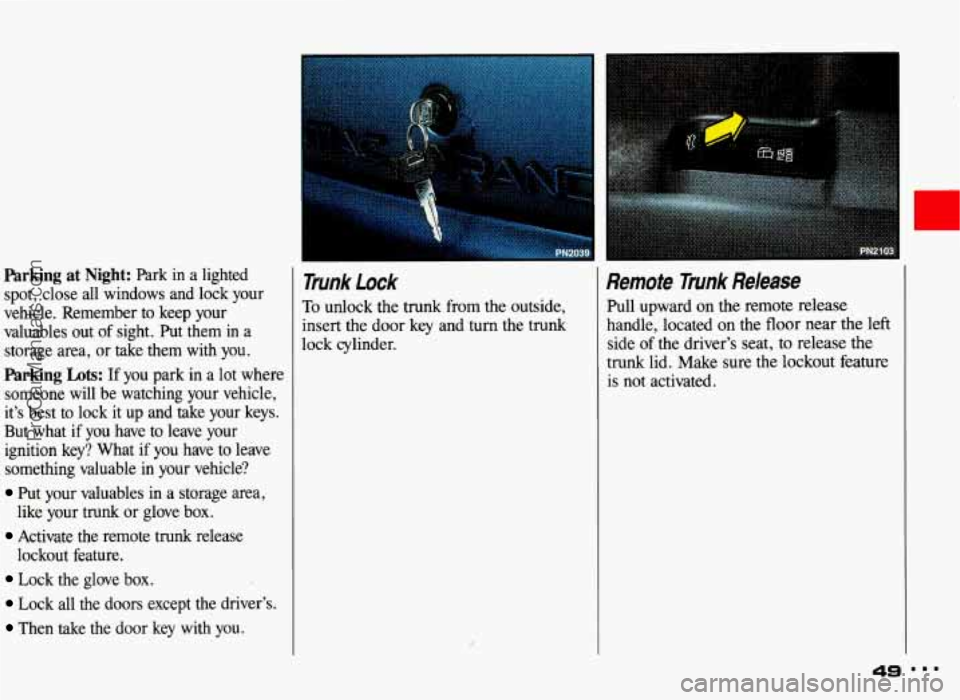
Parking at Night: Park in a lighted
spot, close all windows and lock your
vehicle. Remember to keep your valuables out of sight. Put them in a
storage area, or take them with you.
Parking Lots: If you park in a lot where
someone will be watching your vehicle,
it’s best to lock it up and take your keys.
But what if you have to leave your
ignition key? What if you have to leave something valuable in your vehicle?
Put your valuables in a storage area,
Activate the remote trunk release
Lock the glove box.
Lock all the doors except the driver’s.
Then take the door key with you.
like your trunk
or glove
box.
lockout feature.
Trunk Lock
To unlock the trunk from the outside,
insert the door key and
turn the trunk
lock cylinder.
Remote Trunk Release
Pull upward on the remote release
handle, located on the floor near the left
side of the driver’s seat, to release the
trunk lid. Make sure the lockout feature
is not activated.
ProCarManuals.com
Page 51 of 306
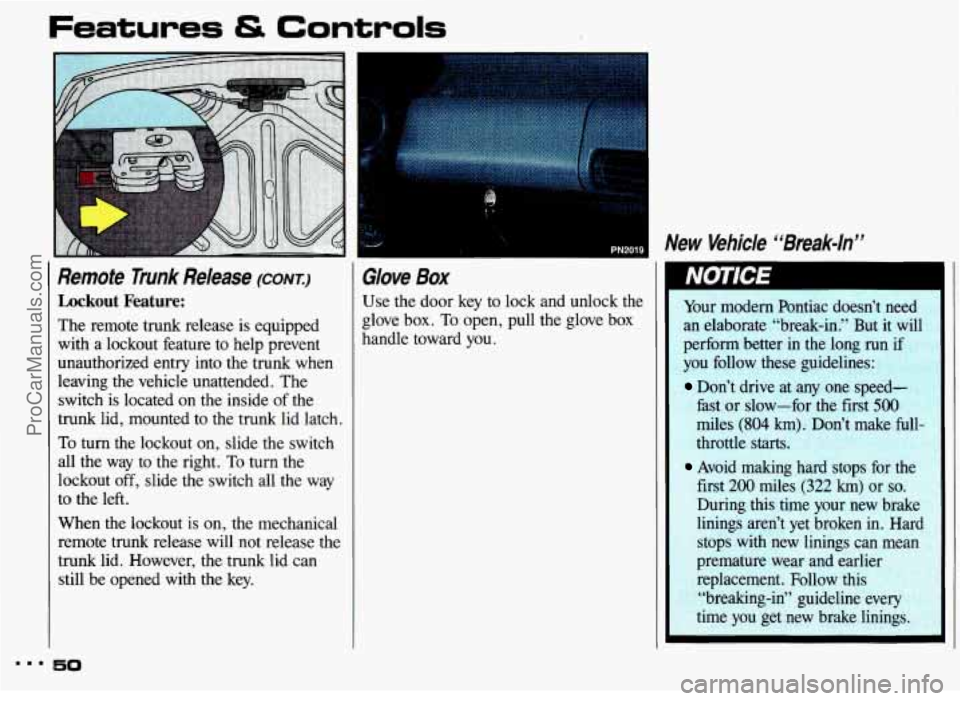
Features & Controls
Remote Trunk Release (CONK)
Lockout Feature:
The remote trunk release is equipped
with a lockout feature to help prevent
unauthorized entry into the trunk when
leaving the vehicle unattended. The
switch is located on the inside of the
trunk lid, mounted to the
trunk lid latch.
To turn the lockout on, slide the switch
all the way to the right.
To turn the
lockout off, slide the switch all the way
to the left.
When the lockout is on, the mechanical
remote trunk release will not release the
trunk lid. However, the trunk lid can
still be opened with the key.
Glove Box
Use the door key to lock and unlock the
glove box. To open, pull the glove box
handle toward you. Your
modern Pontiac doesn’t need
an elaborate “break-in.” But
it will
perform better in the long run if
you follow these guidelines:
Don’t drive at any one speed-
fast or slow-for the first 500
miles (804 km). Don’t make full-
throttle
starts
Avoid making hard st+ for the
first
200 miles (322 km) or so.
During this time your new brake
linings aren’t yet broken in. Hard stops with new linings can mean
premature wear and earlier
replacement. Follow this
“breaking-in” guideline every
time you get new brake linings
ProCarManuals.com
Page 79 of 306
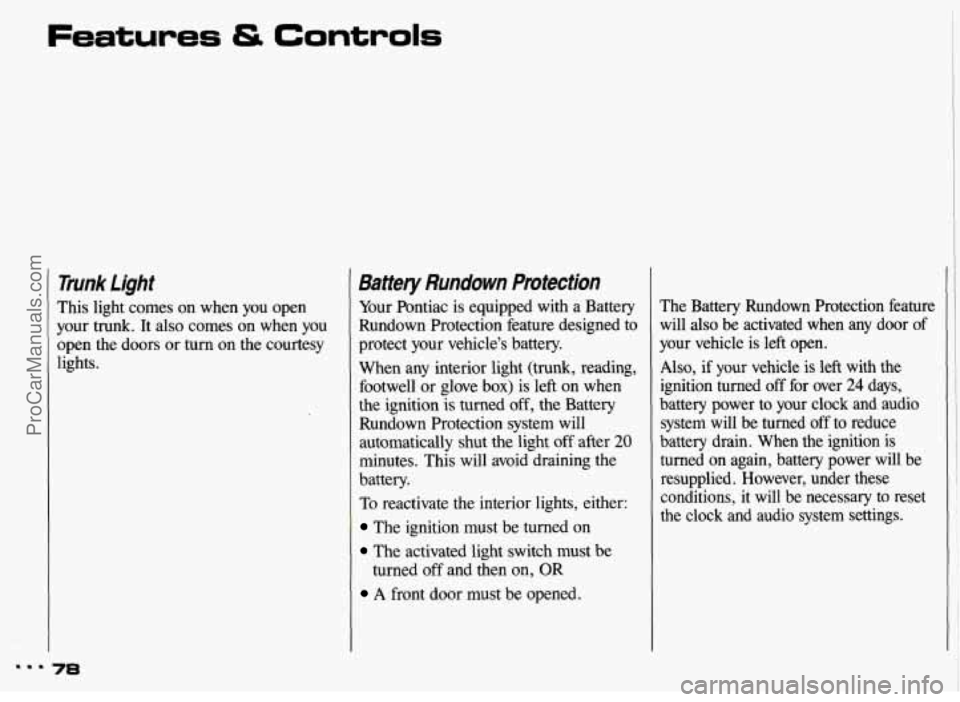
Features & Controls
Trunk Light
This light comes on when you open
your trunk. It also comes on when you
open the doors or turn on the courtesy
lights.
78
Battery Rundown Protection
Your Pontiac is equipped with a Battery
Rundown Protection feature designed to
protect your vehicle’s battery.
When any interior light (trunk, reading,
footwell or glove box) is left on when
the ignition is turned off, the Battery
Rundown Protection system will
automatically shut the light off after
20
minutes. This will avoid draining the
battery.
To reactivate the interior lights, either:
The ignition must be turned on
The activated light switch must be
turned off and then on, OR
A front door must be opened. The Battery Rundown Protection feature
will
also be activated when any door of
your vehicle is left open.
Also,
if your vehicle is left with the
ignition turned
off for over 24 days,
battery power to your clock and audio
system will be turned off to reduce
battery drain. When the ignition is
turned on again, battery power will
be
resupplied. However, under these
conditions, it will be necessary to reset
the clock and audio system settings.
ProCarManuals.com
Page 157 of 306
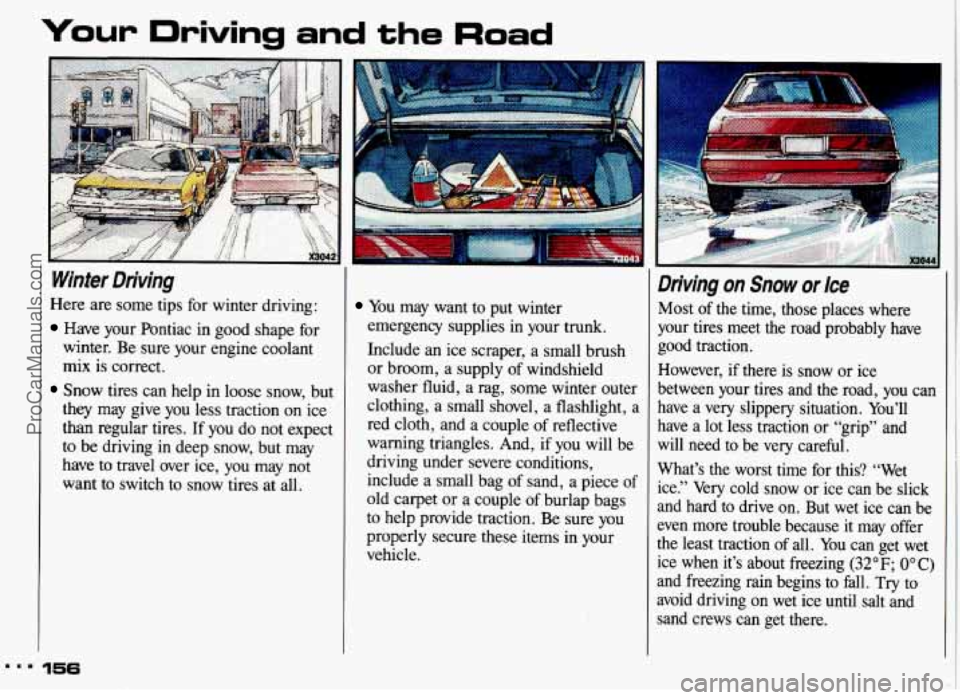
Your Driving and the Road
Winter Driving
Here are some tips for winter driving:
Have your Pontiac in good shape for
winter. Be sure your engine coolant
mix is correct.
Snow tires can help in loose snow, but
they may give you less traction on ice
than regular tires. If you do not expect
to be driving in deep snow, but may
have to travel over ice, you may not
want to switch to snow tires at all.
.a. 156
You may want to put winter
emergency supplies in your trunk.
Include an ice scraper, a small brush
or broom, a supply of windshield
washer fluid, a rag, some winter outer
clothing, a small shovel, a flashlight, a
red cloth, and a couple of reflective
warning triangles. And, if
you will be
driving under severe conditions,
include a small bag of sand, a piece of
old carpet or a couple of burlap bags
to help provide traction. Be sure you
properly secure these items in your
vehicle.
Driving on Snow or Ice
Most of the time, those places where
your tires meet the road probably have
good traction.
However, if there is snow or ice
between your tires and
the road, you can
have a very slippery situation. You’ll
have a lot less traction
or “grip” and
will need to be very careful.
What’s the
worst time for this? “Wet
ice.” Very cold snow or ice can be slick
and hard to drive on. But wet ice can be
even more trouble because it may offer
the least traction of all. You can get wet
ice when it’s about freezing
(32°F; OOC)
and freezing rain begins to fall. Try to
avoid driving on wet ice until salt and
sand crews can get there.
ProCarManuals.com
Page 188 of 306
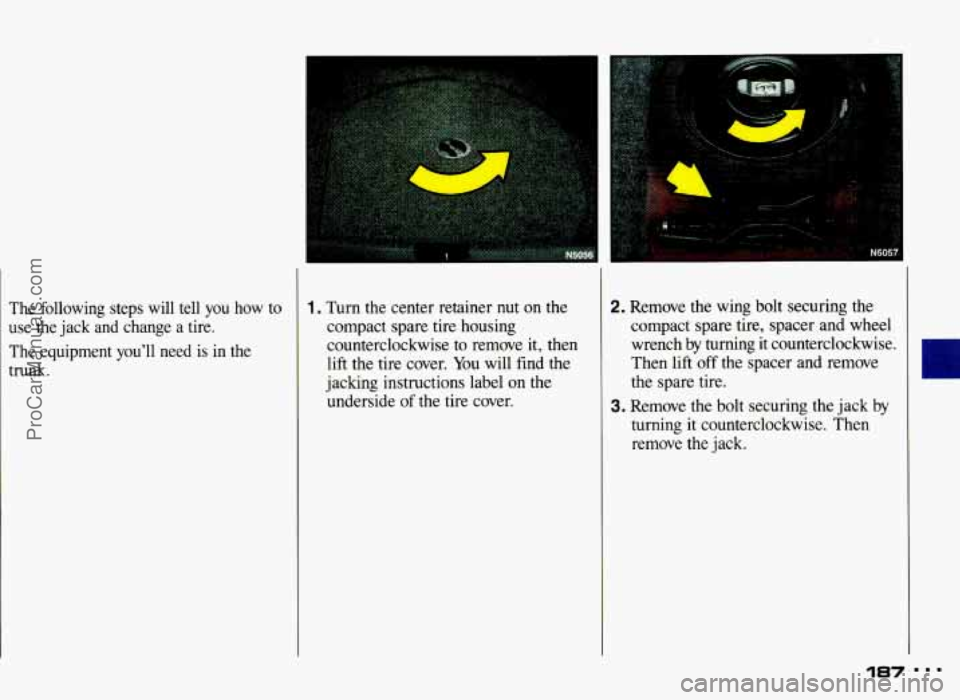
The following steps will tell you how to
use the jack and change a tire.
The equipment you’ll need is in the
trunk.
1. Turn the center retainer nut on the
compact spare tire housing
counterclockwise to remove it, then
lift the tire cover. You will find the
jaclung instructions label on the
underside
of the tire cover.
I
2. Remove the wing bolt securing the
compact spare tire, spacer and wheel
wrench by turning it counterclockwise.
Then lift
off the spacer and remove
the spare tire.
3. Remove the bolt securing the jack by
turning it counterclockwise. Then
remove the jack.
187
ProCarManuals.com
Page 192 of 306
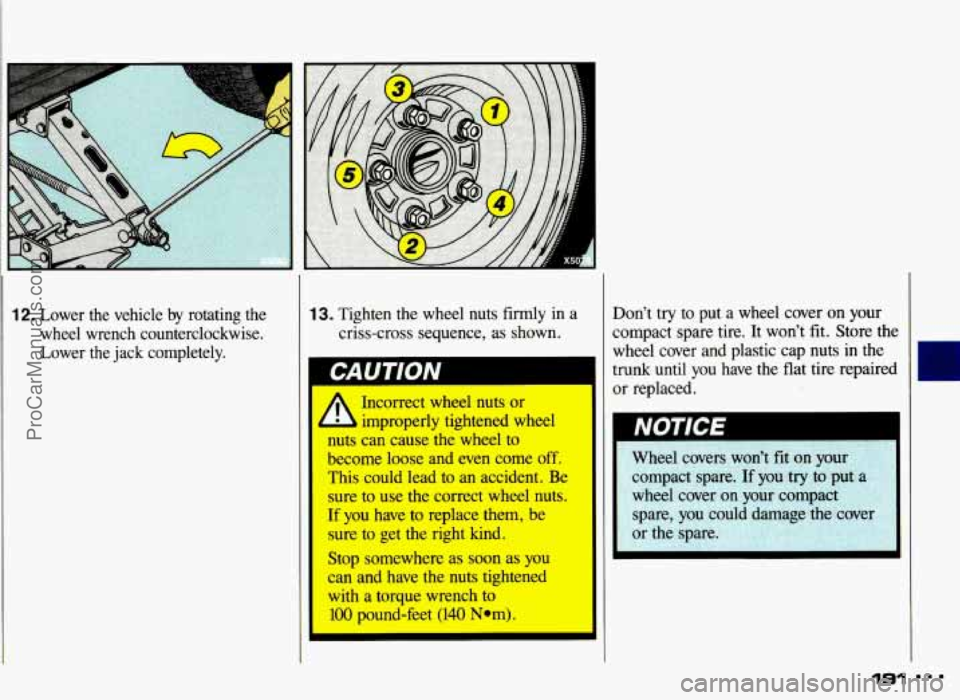
12. Lower the vehicle by rotating the
wheel wrench counterclockwise.
Lower the jack completely. 13. Tighten the wheel nuts firmly in a
criss-cross sequence, as shown.
Incorrect wheel nuts or
- mproperly tightened wheel
nuts can cause the wheel to
become loose and even come
off.
This could lead to an accident. Be
sure to use the correct wheel nuts.
If
you have to replace them, be
sure to get the right kind.
Stop somewhere as soon as
you
can and have the nuts tightened
with a torque wrench
to
100 pound-feet (140 Nom). Don't
try to put a wheel cover on your
compact spare tire.
It won't fit. Store the
wheel cover and plastic cap nuts in the
trunk until you have the flat tire repaired
or replaced.
NOTICE
IS1
ProCarManuals.com
Page 230 of 306
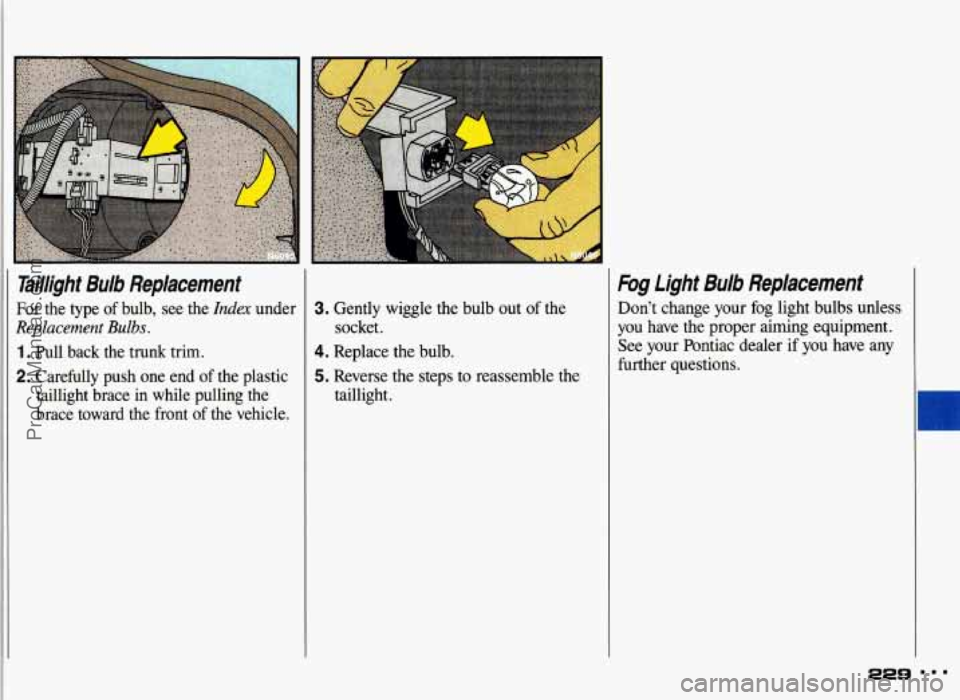
raillight Bulb Replacement
For the type of bulb, see the Index under
Replacement Bulbs.
1. Pull back the trunk trim.
2. Carefully push one end of the plastic
taillight brace in while pulling the
brace toward the front of the vehicle.
3. Gently wiggle the bulb out of the
4. Replace the bulb.
5. Reverse the steps to reassemble the
socket.
taillight.
Fog Light Bulb Replacement
Don’t change your fog light bulbs unless
you have the proper aiming equipment.
See your Pontiac dealer if you have any
further questions.
ProCarManuals.com
Page 231 of 306
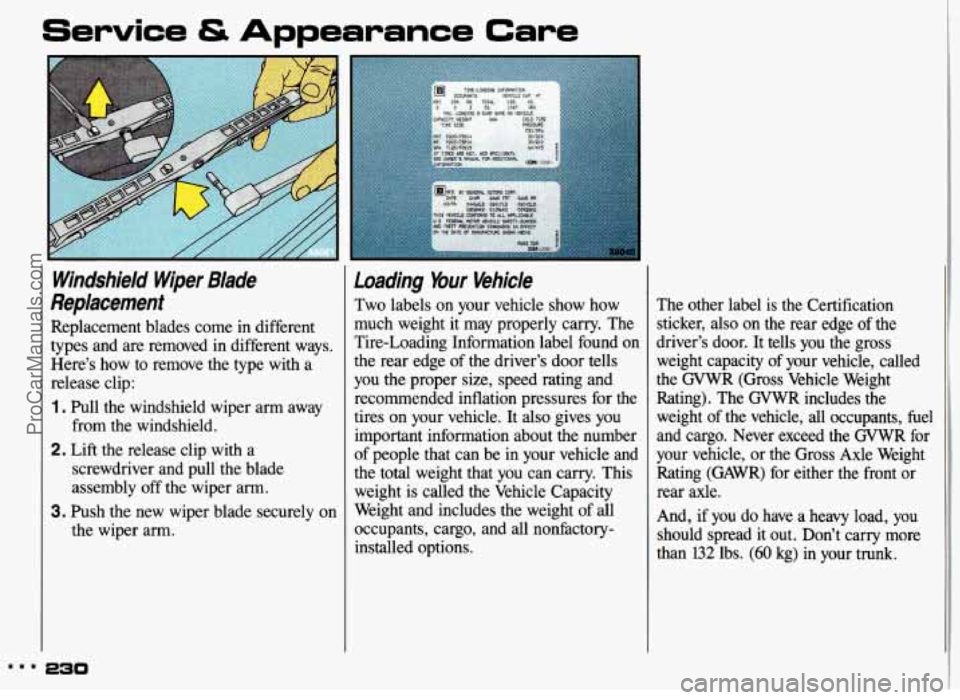
Service & Appearance Care
Windshield Wiper Blade
Replacement
Replacement blades come in different
types and are removed in different ways.
Here’s how to remove the type with a
release clip:
1 . Pull the windshield wiper arm away
2. Lift the release clip with a
from the windshield.
screwdriver and pull the blade
assembly off the wiper arm.
the wiper arm.
3. Push the new wiper blade securely on
Loading bur Vehicle
Two labels on your vehicle show how
much weight it may properly carry. The
Tire-Loading Information label found on
the rear edge of the driver’s door tells
you the proper size, speed rating and recommended inflation pressures for the
tires on your vehicle. It also gives
you
important information about the number
of people that can be in your vehicle and
the total weight that you can carry. This
weight is called the Vehicle Capacity
Weight and includes the weight of all
occupants, cargo, and all nonfactory- installed options. The other label is the Certification
sticker, also on the rear edge of the
driver’s door. It
tells you the gross
weight capacity of your vehicle, called
the GVWR (Gross Vehicle Weight
Rating). The GVWR includes the
weight of the vehicle, all occupants, fuel
and cargo. Never exceed the GVWR for
your vehicle, or the Gross Axle Weight Rating (GAWR) for either the front or
rear axle.
And, if you do have a heavy load, you
should spread it out. Don’t carry more
than
132 lbs. (60 kg) in your trunk.
ProCarManuals.com
Page 232 of 306

IIC
A
Do not load your vehicle any
heavier
than the GVWR or the
maximum
front and rear CiAWRs.
If you do, parts on your vehicle
can
break, or it can change the way
your vehicle handles. These could
cause you to lose control. Also,
overloading
can shorten the life of
your vehicle.
I Your warranty does not cover parts 1
I
or component
overloading.
If you put things inside your vehicle-
like suitcases, tools, packages,
or
anything else-they will go as fast as the
vehicle goes.
If you have to stop or turn
quickly, or if there is a crash, they’ll
keep going.
A
CAUTION
Things you put inside your I
vehicle can strike and injure
people in a sudden stop or turn, or
in a crash.
0 Put things in the tnuik of your
vehicle. In a trunk, put them as
far forward as you can.
* Try tu spread the weight evenly.
Never stack heavier things, like
suitcases, inside the vehicle so
that some of them are above the
tops
of the seats.
When you carry something
inside
the vehicle, secure it
whenever
you can.
Don’t leave a seat folded down
unless you
need to. 1:
iE31 ’
ProCarManuals.com
Page 255 of 306
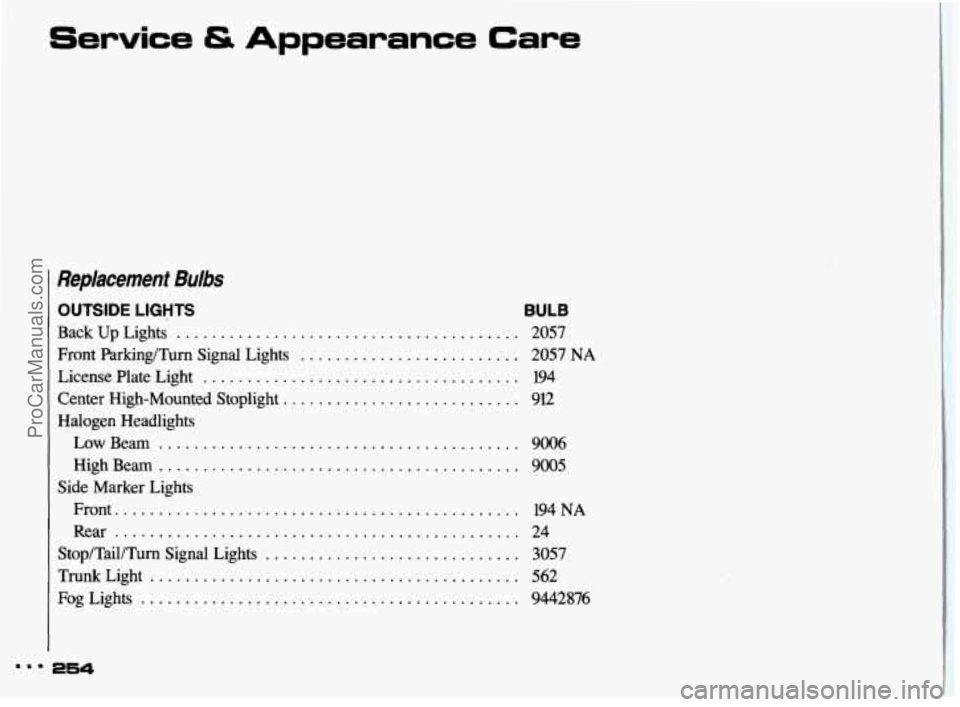
Service & Appearance Care
Replacement Bulbs
OUTSIDE LIGHTS
Back Up Lights .......................................
Front Parking/Turn Signal Lights .........................
License Plate Light ....................................
Center High-Mounted Stoplight ...........................
Halogen Headlights Low Beam
..... ................ .........
HighBe am .........................................
Front ..............................................
Rear ..............................................
TrunkLight ..........................................
FogLights ...........................................
Side Marker Lights
Stop/Tail/Turn Signal Lights
.............................
BULB
2057
2057
NA
194
912
9006
9005
194 NA
24
3057
562
9442876
mmm 254
ProCarManuals.com